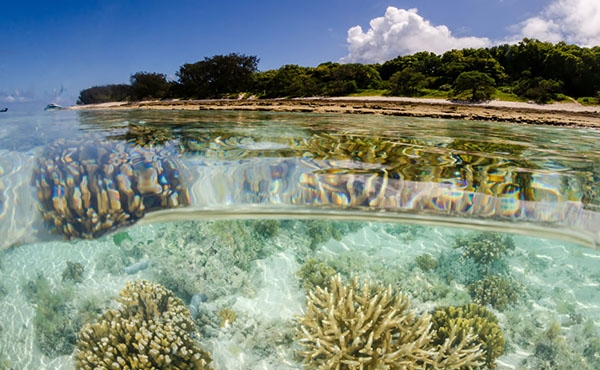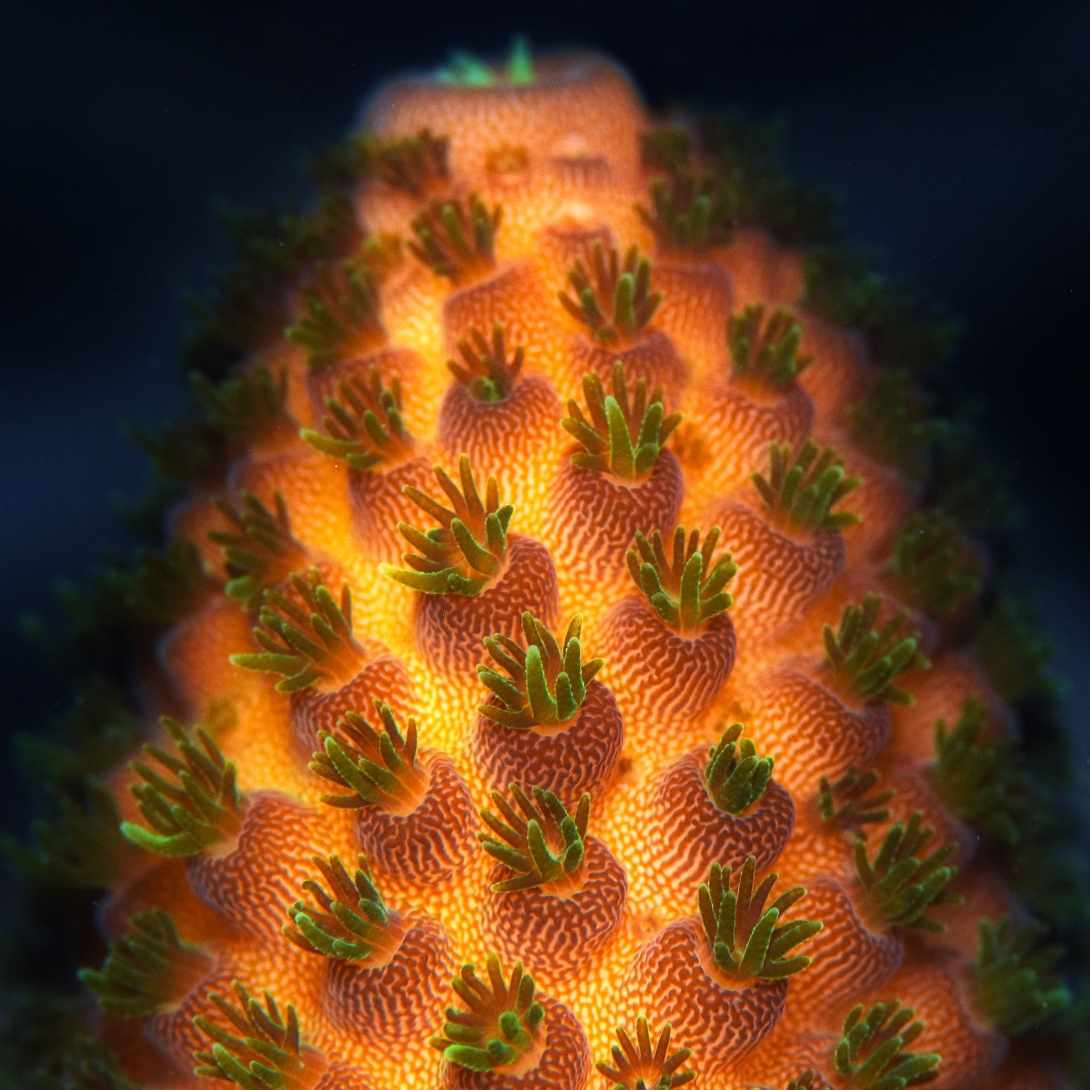31.
Fuller, Z.L., Mocellin, V.J., Morris, L.A., Cantin, N., Shepherd, J., et al. 2020, Population genetics of the coral Acropora millepora: Toward genomic prediction of bleaching, Science 369(6501): eaba4674
285.
Mies, M. 2019, Evolution, diversity, distribution and the endangered future of the giant clam–Symbiodiniaceae association, Coral Reefs 38: 1067-1084.
288.
Quigley, K.M., Ramsby, B., Laffy, P., Harris, J., Mocellin, V.J.L., et al. 2022, Symbioses are restructured by repeated mass coral bleaching, Science Advances 8(49): eabq8349.
323.
Stella, J.S., Munday, P.L., Walker, S.P.W., Pratchett, M.S. and Jones, G.P. 2014, From cooperation to combat: adverse effect of thermal stress in a symbiotic coral-crustacean community, Oecologia 174: 1187-1195.
532.
DeCarlo, T.M. and Harrison, H.B. 2019, An enigmatic decoupling between heat stress and coral bleaching on the Great Barrier Reef, PeerJ 7: e7473.
571.
Lesser, M.P. 2021, Eutrophication on coral reefs: What is the evidence for phase shifts, nutrient limitation and coral bleaching, BioScience 71(12): 1216-1233.
647.
Smale, D.A., Wernberg, T., Oliver, E.C., Thomsen, M., Harvey, B.P., et al. 2019, Marine heatwaves threaten global biodiversity and the provision of ecosystem services, Nature Climate Change 9(4): 306-312.
672.
Hoegh-Guldberg, O. and Dove, S. 2019, Primary production, nutrient recycling and energy flow through coral reef ecosystems, The Great Barrier Reef: Biology, Environment and Management. Second Edition: 85-100.
683.
Gonzalez‐Espinosa, P.C. and Donner, S.D. 2021, Cloudiness reduces the bleaching response of coral reefs exposed to heat stress, Global Change Biology 27(15): 3474-3486.
684.
Rosic, N., Rémond, C. and Mello-Athayde, M.A. 2020, Differential impact of heat stress on reef-building corals under different light conditions, Marine Environmental Research 158: 104947.
720.
Reich, H.G., Tu, W., Rodriguez, I.B., Chou, Y., Keister, E.F., et al. 2021, Iron availability modulates the response of endosymbiotic dinoflagellates to heat stress, Journal of Phycology 57(1): 3-13.
721.
Reich, H.G., Rodriguez, I.B., LaJeunesse, T.C. and Ho, T. 2020, Endosymbiotic dinoflagellates pump iron: differences in iron and other trace metal needs among the Symbiodiniaceae, Coral Reefs 39(4): 915-927.
777.
Voolstra, C.R., Raina, J., Dörr, M., Cárdenas, A., Pogoreutz, C., et al. 2024, The coral microbiome in sickness, in health and in a changing world, Nature Reviews Microbiology: 1-16.
847.
Baker, D.M., Freeman, C.J., Wong, J.C., Fogel, M.L. and Knowlton, N. 2018, Climate change promotes parasitism in a coral symbiosis, The ISME journal 12: 921-930.
848.
Galand, P.E., Ruscheweyh, H., Salazar, G., Hochart, C., Henry, N., et al. 2023, Diversity of the Pacific Ocean coral reef microbiome, Nature Communications 14(1): 3039.
849.
Burns, A.L., Wilson, A.D.M. and Ward, A.J.W. 2019, Behavioural interdependence in a shrimp‐goby mutualism, Journal of Zoology 308(4): 274-279.
850.
Neo, M.L., Eckman, W., Vicentuan, K., Teo, S.L. and Todd, P.A. 2015, The ecological significance of giant clams in coral reef ecosystems, Biological Conservation 181: 111-123.
851.
Scott, A., Hoey, A. S. 2017, Severe consequences for anemonefishes and their host sea anemones during the 2016 bleaching event at Lizard Island, Great Barrier Reef, Coral Reefs 36: 873.
852.
Hobbs, J.A., Frisch, A.J., Ford, B.M., Thums, M., Saenz-Agudelo, P., et al. 2013, Taxonomic, spatial and temporal patterns of bleaching in anemones inhabited by anemonefishes, PloS One 8(8): e70966.
853.
Helgoe, J., Davy, S.K., Weis, V.M. and Rodriguez‐Lanetty, M. 2024, Triggers, cascades, and endpoints: connecting the dots of coral bleaching mechanisms, Biological Reviews.
854.
Rädecker, N., Pogoreutz, C., Gegner, H.M., Cárdenas, A., Roth, F., et al. 2021, Heat stress destabilizes symbiotic nutrient cycling in corals, Proceedings of the National Academy of Sciences 118(5): e2022653118.
855.
Fan, L., Liu, M., Simister, R., Webster, N.S. and Thomas, T. 2013, Marine microbial symbiosis heats up: Loss of interactions in a sponge holobiont under thermal stress, ISME Journal 7: 991-1002.
856.
Botté, E.S., Bennett, H., Engelberts, J.P., Thomas, T., Bell, J.J., et al. 2023, Future ocean conditions induce necrosis, microbial dysbiosis and nutrient cycling imbalance in the reef sponge Stylissa flabelliformis, ISME Communications 3(1): 53.
857.
Alderdice, R., Perna, G., Cárdenas, A., Hume, B.C.C., Wolf, M., et al. 2022, Deoxygenation lowers the thermal threshold of coral bleaching, Scientific Reports 12(1): 18273.
858.
Claar, D.C., Starko, S., Tietjen, K.L., Epstein, H.E., Cunning, R., et al. 2020, Dynamic symbioses reveal pathways to coral survival through prolonged heatwaves, Nature Communications 11(1): 6097.
859.
Prazeres, M., Roberts, T.E., Pandolfi, J.M. 2017, Variation in sensitivity of large benthic Foraminifera to the combined effects of ocean warming and local impacts, Scientific Reports 7(1): 45227.
860.
Prazeres, M., Uthicke, S. and Pandolfi, J.M. 2016, Influence of local habitat on the physiological responses of large benthic foraminifera to temperature and nutrient stress, Scientific Reports 6: 21936.
861.
Berkelmans, R. and van Oppen, M.J. 2006, The role of zooxanthellae in the thermal tolerance of corals: a ‘nugget of hope’for coral reefs in an era of climate change, Proceedings of the Royal Society B: Biological Sciences 273(1599): 2305-2312.
862.
Puntin, G., Craggs, J., Hayden, R., Engelhardt, K.E., McIlroy, S., et al. 2023, The reef-building coral Galaxea fascicularis: a new model system for coral symbiosis research, Coral Reefs 42(1): 239-252.
863.
Quigley, K.M., Willis, B.L. and Kenkel, C.D. 2019, Transgenerational inheritance of shuffled symbiont communities in the coral Montipora digitata, Scientific Reports 9(1): 13328.
864.
Pernice, M., Raina, J., Rädecker, N., Cárdenas, A., Pogoreutz, C., et al. 2020, Down to the bone: the role of overlooked endolithic microbiomes in reef coral health, The ISME Journal 14(2): 325-334.
865.
van Oppen, M.J. and Blackall, L.L. 2019, Coral microbiome dynamics, functions and design in a changing world, Nature Reviews Microbiology 17(9): 557-567.
866.
Prazeres, M., Ainsworth, T., Roberts, T.E., Pandolfi, J.M. and Leggat, W. 2017, Symbiosis and microbiome flexibility in calcifying benthic foraminifera of the Great Barrier Reef, Microbiome 5(1): 38-7.
867.
Webster, N.S. and Reusch, T.B.H. 2017, Microbial contributions to the persistence of coral reefs, The ISME Journal 11(10): 2167.
868.
Robbins, S.J., Singleton, C.M., Chan, C.X., Messer, L.F., Geers, A.U., et al. 2019, A genomic view of the reef-building coral Porites lutea and its microbial symbionts, Nature Microbiology 4(12): 2090-2100.



